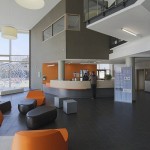Flowers Laboratory
FLOWing Epigenetic Robots and Systems
Tour of the Web of February
Each month, I collect interesting stories related to the scientific interest of the team, in science, robotics, and education. Here are the highlights of February.
Hard Science
Scientists have observed a curious trend that seems to affect their research. They first publish a result about a brand new observed effect, that they conclusively prove. Then other studies of the phenomenon come from other scientists, largely corroborating the new idea. But then, the effect observed looses in strength as the years and studies pile on. The authors of the original research themselves find themselves unable to replicate their original findings, despite the apparent absence of errors in methodology in the original article. Jonathan Schooler, victim of the phenomenon, termed the effect “cosmic habituation”, as if nature was habituating to scientist ideas over time. This draw a somber and sobering picture of the effect the scientist has on its data.
New Yorker article:
http://www.newyorker.com/reporting/2010/12/13/101213fa_fact_lehrer?currentPage=all
The problem of bad published results is beginning to dawn enough on scientists that some of them are organising. John Ioannidis in particular, author of the 2005 article “Why most published research findings are false”, worked to develop meta-research, or research about research, and is launching the Meta-Research Innovation Centre at Stanford next month.
The Economist article:
http://www.economist.com/news/science-and-technology/21598944-sloppy-researchers-beware-new-institute-has-you-its-sights-metaphysicians
Journal article “Why most published research findings are false”:
http://www.plosmedicine.org/article/info%3Adoi%2F10.1371%2Fjournal.pmed.0020124
No Science Left Behind
The New York Times and Nature are running a piece on how American science is increasingly financed by wealthy individuals, in a background of budget cuts. The money is usually aimed at trendy subjects, which could skew scientific research to the detriment of less sexy fields and basic research, which prompted Nature to publish a warning in that sense.
New York Time article:
http://www.nytimes.com/2014/03/16/science/billionaires-with-big-ideas-are-privatizing-american-science.html
Nature article:
http://www.nature.com/neuro/journal/v11/n10/full/nn1008-1117.html
Concurrently, the Brain initiative got a big boost in public financing from (announced by) Obama, from $100 millions to $200 millions. The project scientific committee also published a report with a more detailed list of the goals of the initiative.
White House press release:
http://www.whitehouse.gov/sites/default/files/microsites/ostp/FY%202015%20BRAIN.pdf
Executive summary (6 pages):
http://acd.od.nih.gov/presentations/BRAIN-Interim-Report-Executive-Summary.pdf
Education
Math “is fundamentally about patterns and structures, rather than “little manipulations of numbers,”” says math educator Maria Droujkov. But with the way the mathematics are taught, she claims, it is hard to get that, and the mechanical drills that are imposed on us from an early age often prevents children from enjoying mathematics for life. Droujkov defends the idea of going from “simple but hard” activities (rote learning of multiplication tables) to “complex but easy” ones (legos or snowflakes cut-outs to learn symmetry). Well worth the read.
The Atlantic article:
http://www.theatlantic.com/education/archive/2014/03/5-year-olds-can-learn-calculus/284124/
The Computing Research Association has published a sneak preview of its 2013 Taulbee Report, to be published in May in CRN, which looks at enrolment figure in CS for the US. The most notable part is the 22% increase in BS enrolment year-over-year.
Press release:
http://cra.org/resources/crn-online-view/2013_taulbee_report_sneak_preview/
The robot is coming from the US, but the – open source – software suite that powers it is French. And it is in a the lycée la Martinière Monplaisir, in Lyon, that it is being deployed. This telepresence robot is aimed at students unable to be physically present for temporary periods. It makes interacting in class possible, with the teacher and other students, through what they call, tongue-in-cheek, the “robodylanguage”. (shared by Nicolas Jahier)
LyonMag article (in french):
http://www.lyonmag.com/article/61805/le-premier-robot-lyceen-a-ete-presente-a-lyon
Video from FranceTVInfo (in french):
http://www.francetvinfo.fr/societe/education/video-un-robot-lyceen-va-en-cours-a-la-place-des-eleves_511097.html
Musician Cyborg
Science meets art, and creates new things. Gil Weinberg of the Georgia Tech Center for Music Technology (which he founded), created (more probably, supervised the creation of) a robotic prothesis that uses electromyography to control a first drumstick. A second drumstick is also present on the prothesis, but is controlled algorithmically. For the moment, the second drumstick is a on an open loop, with the drummer, Jason Barnes, being the close loop by responding to the rhythms of the second sticks. In the perspective, synchronisation routines and machine learning are envisioned to create a more reactive, yet autonomous second stick.
Video:
http://www.youtube.com/watch?v=ntrlHw6f4E4
Press release:
http://www.gtcmt.gatech.edu/news/robotic-prosthesis-turns-drummer-into-a-three-armed-cyborg
Robots are less impressed by a three-drumsticks drummer. After all, coming from Japan with a 22-arms drummer and 78-fingers guitar player, they are showing off their ability to handle arbitrarily many way of independence. Squarepusher, the composer, is pushing the notion that for music to be emotionally powerful, it doesn’t necessarily have to be performed by humans. (shared by Clément Moulin-Frier)
Pitchfork short story (with video):
http://pitchfork.com/news/53991-squarepusher-collaborates-with-robots-on-new-ep/




